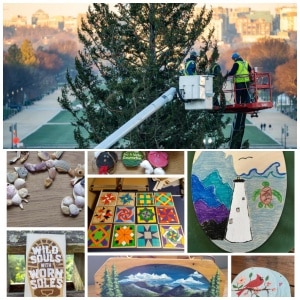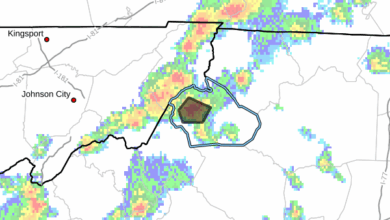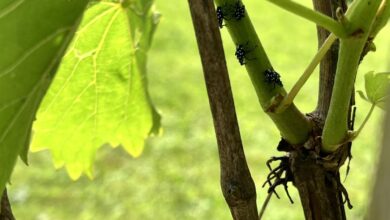
Last Updated on November 28, 2022 4:58 pm
Asheville, NC, November 28, 2022 – Ruby the Red Spruce from the Pisgah National Forest has been delivered to the U.S. Capitol, decorated with thousands of ornaments hand made by North Carolinians, and will be lit in a public ceremony on Tuesday, November 29.
Hailing from the mountains of North Carolina, the 78-foot-tall red spruce will adorn the U.S. Capitol grounds this holiday season as the 2022 U.S. Capitol Christmas Tree. Also known as the People’s Tree because it is a gift from the people’s public lands to the U.S. Capitol Building – the people’s house – where it stands for all to see, the tree will be lit from dusk through 11:00 p.m. each night through January 1, 2023. The tree’s nickname “Ruby” is shortened from the red spruce’s scientific name, Picea rubens.
Every year since 1970, the USDA Forest Service has provided a Christmas tree, commonly known as “The People’s Tree,” to. The Christmas Tree serves as a reminder of the majestic forests, grassy meadows, awesome expanses of grasslands, ancient wind-swept deserts, and the diverse landscapes in between that are for all Americans to use and enjoy. This year the People’s Tree comes from the Pisgah National Forest, nestled within a high-elevation spruce-fir forest in the southern Appalachians. In fact, this is the third time the Pisgah National Forest has been selected to provide the tree since 1974 and 1998.
Finding Ruby
Yes, Ruby may have made the cut, but the tree had heavy competition and passed several important tests along the way. To start, a team of biologists, silviculturists, forestry technicians, and arborists spent months combing the mountainsides of the Pisgah and Nantahala National Forests looking for just the right tree.
Specifically, the team was looking for a tree that fit the mold of a traditional Christmas tree. In western North Carolina, that could only mean a red spruce or Fraser fir, these being the only traditional Christmas tree species found in the state.
Apart from looking like a Christmas tree, the team needed to consider other characteristics. For instance, the tree had to be very tall, at least 65 feet, so that people can see it from far and wide around the National Mall in Washington, D.C. It also had to be well hydrated to remain healthy through the holiday season. Not to mention that it needed to grow close to a road to ensure the arborists could harvest the tree with the absolute minimum disturbance to other trees and wildlife.
In the end, Ruby was chosen over seven other trees, all red spruce, but not until the team had a final, thorough inspection to be sure Ruby was the best fit.
One of the main criteria of the inspection? Make sure Ruby the Red Spruce wasn’t home to any critters that were not expecting to make a trip to the capital this holiday season. You may be wondering; how does one inspect a 78-foot-tall tree? Well, we climb it, of course.
On a crisp July day in the middle of summer atop a 6,000-foot mountain peak, a group of arborists, biologists, foresters, climbers, and silviculturists gathered, equipped with their climbing gear, ready to inspect the top candidate trees.
“We’ll need to check hollow areas deeper than 5 inches,” said biologist Tara Anderson as she demonstrated the use of a cable camera to climber and forester William Preston. “We’ll also need to check for the lichen hot dots, an important food source for the Carolina northern flying squirrel.”
At the end of the day, Ruby passed the test. The climbers scrambled over every inch of the 78-foot spruce and found no signs of squirrels, spiders, or lichens.
Ruby Leaves a Lasting Legacy in Southern Appalachia
Ruby is already leaving a legacy that will benefit the spruce-fir ecosystems of southern Appalachia for generations to come, making the time standing on the Capitol grounds even more meaningful. This year’s tree is contributing to a movement among land managers in the southern Appalachian region to redouble efforts to restore red spruce habitat. As part of the U.S. Capitol Christmas Tree Program, the Forest Service is partnering with the National Forest Foundation to raise funds for a new state-of-the-art nursery that will grow red spruce seedlings. So far, the Forest Service has raised $50,000 and the National Forest Foundation plans on raising $200,000 more.
The nursery will be managed by the Southern Highlands Reserve a nationally recognized nonprofit arboretum and research center. This organization has embarked upon the epic task of raising 50,000 new red spruce trees from seed to be planted on public lands in North Carolina, Eastern Tennessee and Virginia, where more than 6,000 Southern Highland Reserve trees are already planted. Other partners in these restoration efforts include The Nature Conservancy and the U.S. Fish and Wildlife Service.
“We are very excited to partner with the U.S. Forest Service and Southern Highlands Reserve on efforts to restore these unique, high-elevation, spruce-fir forests of North Carolina, Tennessee, and Virginia,” said Mark Shelley, director of eastern programs for the National Forest Foundation. “We are actively working to create a supply of trees to meet these restoration goals.”
Ruby’s offspring may play a role as well. The team of silviculturists and foresters that helped select Ruby has also collected Ruby’s cones, which contain seeds that will be transported to a tree nursery to be stored and eventually grown into seedlings. These seedlings may be among the next generation of red spruce trees growing in places across the southern Appalachian region that need them the most. Through the U.S. Capitol Christmas Tree Program, Ruby is helping to raise awareness of these iconic trees and the ecosystems they support.
Spreading Holiday Cheer
While climbers, biologists, arborists, and foresters were busy searching for the future People’s Tree, Forest Service employees across the state connected with local communities to create and gather ornaments to adorn the tree, as well as smaller Christmas trees that will be displayed throughout Washington, D.C. and in the homes of military service member families this year. In six months, over 12,000 ornaments were decorated and donated by schools, communities, and civic organizations across North Carolina, as well as partner agencies and organizations and hundreds of North Carolinians across the state.
These ornaments represent over 125 local communities, Forest Service employees, families and friends, four national forests, and neighbors from thirteen other states. In this sense, the 2022 U.S. Capitol Christmas Tree truly embodies “The People’s Tree.”
Highlights from Ruby’s journey from the Pisgah National Forest through North Carolina communities from the mountains to the sea and to Washington, D.C. can be seen on Facebook and Instagram @uscapitolchristmastree.

















